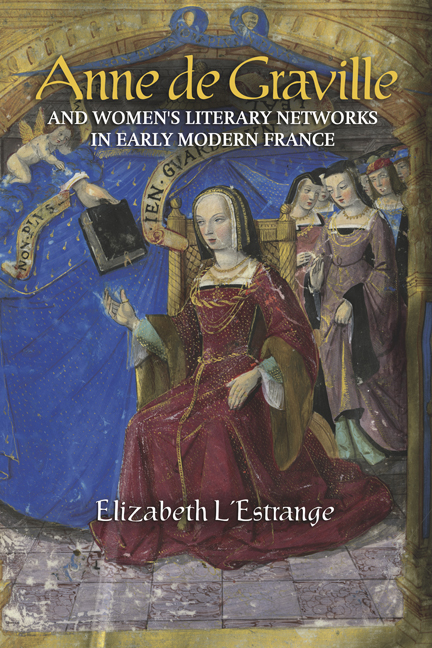Book contents
- Frontmatter
- Dedication
- Contents
- List of Illustrations
- Acknowledgements
- A Note on Citations, Translations and Transcriptions
- List of Abbreviations
- Map
- Introduction: ‘Une femme d’excellence en vertus, ma dame d’Entraigues’: Anne de Graville’s Life and Works
- PART I ANNE DE GRAVILLE: READER AND COLLECTOR
- PART II FROM READING TO WRITING: ANNE AS AUTHOR
- Conclusion: ‘Celle la qui porte le regnon’: A Last Word on Anne de Graville
- Appendix A Books Inherited, Acquired, Commissioned by or Associated with Anne de Graville
- Appendix B Inventory of the d’Urfé Library at La Bâtie, c. 1780
- Appendix C Manuscripts Containing Works by Anne de Graville
- Bibliography
- Index
- Gallica
1 - J’en garde un leal: Reconstructing Anne de Graville’s Library
Published online by Cambridge University Press: 11 January 2024
- Frontmatter
- Dedication
- Contents
- List of Illustrations
- Acknowledgements
- A Note on Citations, Translations and Transcriptions
- List of Abbreviations
- Map
- Introduction: ‘Une femme d’excellence en vertus, ma dame d’Entraigues’: Anne de Graville’s Life and Works
- PART I ANNE DE GRAVILLE: READER AND COLLECTOR
- PART II FROM READING TO WRITING: ANNE AS AUTHOR
- Conclusion: ‘Celle la qui porte le regnon’: A Last Word on Anne de Graville
- Appendix A Books Inherited, Acquired, Commissioned by or Associated with Anne de Graville
- Appendix B Inventory of the d’Urfé Library at La Bâtie, c. 1780
- Appendix C Manuscripts Containing Works by Anne de Graville
- Bibliography
- Index
- Gallica
Summary
Around the time of their marriage in 1507, Pierre de Balsac offered his wife, Anne de Graville, a luxurious manuscript illuminated by the Master of the Chronique scandaleuse. The frontispiece depicts a centrally seated Anne reaching up to take a book, offered to her by a disembodied hand guided by Cupid (fig. 7). A group of men and women gather behind her chair and a banderol with an anagram of Anne's name, j’en garde un leal, floats above her head. Below, in the bas-de-page, is the Graville coat of arms, de gueules, à trois fermaux d’or(red with three gold buckles), and on the opposite folio, a dedicatory prologue praises Anne and introduces the work that follows as that of Berosus the Chaldean. In contrast to the miniature in the Beau romanin which Anne is depicted as an authorpresenting her work to Queen Claude (fig. 2), the opening miniature of the Chaldean Historiesclearly positions Anne as a discerning recipient– and by implication, reader– of high-quality, and original, books. This manuscript, its illustration and its text – actually a translation of Annius da Viterbo's 1498 Antiquities– is the principal subject of the next chapter, but its opening miniature is a fitting place to begin this discursive reconstruction and analysis of Anne's collection. The Chaldean Historiesand other volumes owned by Anne bear witness to her participation in a long-standing tradition of book culture in and around the French court, one in which women were serious players. This chapter shows how Anne carefully crafted her collection in relation to her personal interests – familial as well as literary – and points to the fundamental role her books and reading played in establishing her as a writer in the patronage of royal women.
Between Graville and d’Urfé: Problems, Sources, and Evidence for Defining Anne's Library
Despite never having been the subject of a full-length modern study, Anne de Graville has frequently been evoked in studies into late medieval women's book ownership for the size and importance of her collection. These evocations have, however, relied largely on Montmorand's 1917 biography of Anne in which he stated that Anne probably inherited most of the manuscripts that her father had collected, as well as on studies of the d’Urfé library.
- Type
- Chapter
- Information
- Publisher: Boydell & BrewerPrint publication year: 2023



